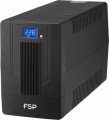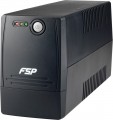Full load operating time
UPS continuous operation time from a fully charged battery when connected to a load with a power equal to the UPS output power (maximum or effective, depending on the type of load, see the relevant paragraphs for details). For a UPS designed to work with a home or office PC, a time of about 10-15 minutes is considered sufficient, this is enough to save data and complete work. To power servers, it is worth using devices with an operating time
of 20 minutes or more.
Half load operating time
UPS continuous operation time from a fully charged battery when connected to a load with a power equal to half the output power of the UPS (maximum or effective, depending on the type of load, see below for details). The operating time with such a load is much longer than for a full load, and even in the simplest models it can reach 20-30 minutes.
Input voltage range
In this case, the input voltage range is implied, in which the UPS is able to supply a stable voltage to the load only due to its own regulators, without switching to the battery. For redundant UPSs (see "Type") this range is quite small, approximately 190 to 260 V; for interactive and especially inverter ones, it is much wider. Some UPS models allow you to manually set the input voltage range.
Output voltage accuracy
This parameter characterizes the degree of difference between the AC voltage at the output of the UPS and the perfect voltage, the graph of which has the shape of a regular sinusoid. The perfect voltage is so named because it is the most uniform and creates the least unnecessary load on the connected devices. Thus, the distortion of the output voltage is one of the most important parameters that determine the quality of the power received by the load. A distortion level of 0% means that the UPS produces a perfect sine wave, up to 5% — slight sine wave distortion, up to 18% — strong distortion, from 18% to 40% — a trapezoidal signal, more than 40% — a square wave.
Output frequency
The frequency (frequency range) of the AC voltage output by the UPS. For computer technology, the frequency range of 47-53 Hz is considered normal, although the smaller the deviation from the 50 Hz standard, the better. On the other hand, in some UPS models, this frequency can be automatically synchronized with the frequency of the mains — so the power supplied to the load will not differ regardless of whether the load is powered by the mains or from the battery. In this case, a wider frequency range, on the contrary, is more desirable.
Redundant sockets
The number of
outlets connected to the power reserve(battery) provided in the design of the UPS. In order for the UPS to fulfill its main role (providing a backup power in case of power outages), the corresponding electrical appliances must be connected to these outlets. The sockets have a standard shape and are compatible with the vast majority of popular 230 V plugs.
At a minimum, the UPS has
1 or
2 outlets and, in more advanced ones, there may be
3 or
more.
Reserved C13/C14 connectors
Number of
C13/C14 connectors with power reserve provided in the UPS design.
Electrical appliances connected to connectors with a reserve are insured against a power failure in the network - in this case they switch to the battery. The C13/C14 connector itself is also known as a “computer socket”; it supplies the same 230 V as a regular household network, but is not compatible with plugs for traditional sockets, because uses three flat contacts. However, there are adapters between these standards.
At a minimum, the UPS is provided with
1,
2 or
3 C13/C14 connectors for one workstation. In more advanced, so to speak office ones, the number of C13/C14 connectors may be greater -
4 ports,
6 connectors,
8 and even more
Full charge time
The time it takes to fully charge the UPS battery. Note that in this case, this time is calculated according to special rules: not from 0 to 100% of the charge, but from a state in which it is impossible to maintain half the load, up to 90% of the charge. Of course, a full charge will take a little longer. However, this data is closer to practice than the “from 0 to 100%” calculation: the inability to work at half load makes the UPS practically useless, and this condition can be taken as zero, and 90% of the battery is already able to provide a good guarantee in case of a power failure.
Protection
The protection functions provided in the design of the UPS.
—
Short circuit protection. A short circuit is a sharp drop in load resistance to critically low values, due to which the current strength increases and the UPS experiences significant overloads that can disable the device and even cause a fire. It may be caused by a problem with the connected device, poor insulation, foreign objects, etc. In the event of such a situation, the short circuit protection system turns off the UPS, preventing unpleasant consequences.
—
Overload protection. Overload in this case is the excess of the load power consumption over the output power of the UPS. Working in this mode can also lead to unpleasant consequences up to breakage and fire; to avoid this, a protection system is installed that turns off the UPS when an overload occurs.
—
Overcharging protection of external battery. The overcharge protection function prevents the accumulation of excess energy in the battery, from which the UPS operates in autonomous mode. Overcharging is highly undesirable for any type of battery. It can lead to various unpleasant consequences - from deterioration in performance to overheating and fire of the battery. The automatic protective equipment on board the uninterruptible power supply turns off the power after the battery is fully charged. This prevents “extra” curre
...nt from entering the battery, which could damage it. This system is convenient in that the battery can be left on charge for a long time without fear of overexerting it.
— Noise filtering. A system that suppresses high-frequency interference in an electrical network — these can be either single voltage surges when turning on and off powerful electrical appliances, or long-term interference from constant sources, such as electric motors. These interferences can adversely affect the operation of electronics connected to the network (up to visible failures); the noise filtering system avoids this. Such systems are quite simple, and therefore most modern UPSs are equipped with them.
— Data line protection. High-frequency interference protection system, similar to interference filtering (see above) — only used not in an electrical network, but in a telephone or wired computer (LAN) network. Such networks are also subject to interference from various sources of electromagnetic radiation, which can cause failures of equipment connected to them: PCs, printers, fax machines, etc. UPSs with this feature have at least two LAN standard connectors (input and output), into which appropriate network or telephone (with RJ-11 connectors compatible with LAN) cables are inserted.
— Emergency cut-off. This connector allows you to connect the UPS to an emergency power off system. Thus, in an emergency (for example, in the event of a fire), the entire room, including and with a power reserve, can be completely de-energized by pressing one button. Without this, the UPS would simply switch to battery when the power goes out and leave the equipment energized, which could lead to disastrous consequences.
— Sound alarm. A system that gives an audible signal in various important situations. It is most commonly used to signal a power outage and the UPS is transferring to battery power. Without a sound signal, this could not be noticed at all (the light is not always on in the room, it goes out when the network fails, the contact in the socket itself may disappear, etc.), which is fraught with a sudden shutdown of the equipment, data loss and breakdowns. Also, sound alarm can be used for other events — low battery, end of charge, bypass on / off, etc.
